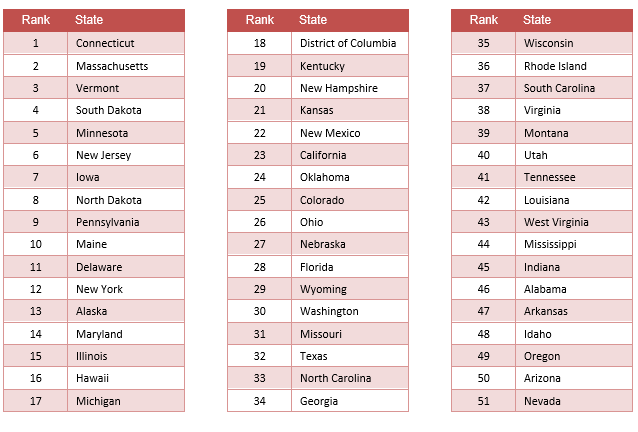You are here
New State Rankings Shines Light on Mental Health Crisis, Show Differences in Blue, Red States
Alexandria, VA—For the third year in a row, Mental Health America (MHA) released its annual State of Mental Health Report, which ranks all 50 states and the District of Columbia based on several mental health and access measures. The results show a country that is indeed more insured, but still falling dramatically short in meeting the needs of those with mental health concerns.
- Health care reform has reduced the rates of uninsured adults with mental health conditions—19 percent remain uninsured in states that did not expand Medicaid, 13 percent remain uninsured in states that did expand Medicaid.
- Over 40 million Americans are dealing with a mental health concern—more than the populations of New York and Florida combined.
- There are over 1.2 million people currently residing in prisons and/or jails with a mental health condition and lack of access to mental health care is linked with higher rates of incarceration.
- 56 percent of adults still don’t receive treatment.
- Youth mental health problems are on the rise, and 6 out of 10 young people with major depression do not receive ANY mental health treatment.
- In states with the lowest workforce, there’s only 1 mental health professional per 1,000 individuals—that includes psychiatrists, psychologists, social workers, counselors and psychiatric nurses combined.
- In the overall rankings, Connecticut came out as #1, while Nevada landed at #51.
“Once again, our report shows that too many Americans are suffering, and far too many are not receiving the treatment they need to live healthy and productive lives,” said Paul Gionfriddo, president and CEO, Mental Health America. “Mental illness touches everyone. We must improve access to care and treatments, and we need to put a premium on early identification and early intervention for everyone with mental health concerns.”
In developing the report, MHA looked at 15 different measures to determine the rankings. MHA hoped to provide a snapshot of mental health status among youth and adults for policy and program planning, analysis, and evaluation; to track changes in prevalence of mental health issues and access to mental health care; to understand how changes in national data reflect the impact of legislation and policies; and to increase the dialogues and improve outcomes for individuals and families with mental health needs.
“This is ultimately about policy decisions we make. It isn’t just about what states are red and what states are blue,” Gionfriddo added, “because there are some of each near the top and the bottom. But political environments in states do seem to matter. Those that invest more in mental health clearly have to throw away less money on jails and prisons.
“It’s time to act—we must invest in the overall physical and mental well-being of our citizens—every day,” concluded Gionfriddo. “We must address these mental health concerns before crisis and tragedy strikes—before Stage 4.”
“It’s time to act—we must invest in the overall physical and mental well-being of our citizens—every day,” concluded Gionfriddo. “We must address these mental health concerns before crisis and tragedy strikes—before Stage 4.”
State of Mental Health in America Overall Ranking

The analysis uses the most recently available state level data.







this page